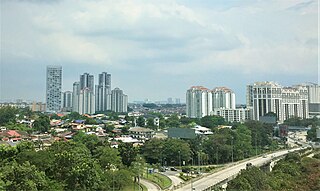
Petaling Jaya, commonly called "PJ" is a city in Petaling District, in the state of Selangor, Malaysia. Originally developed as a satellite township for Kuala Lumpur, the capital of Malaysia, it is part of the Greater Kuala Lumpur area. Petaling Jaya was granted city status on 20 June 2006. It has an area of approximately 97.2 square kilometres (37.5 sq mi).

Ganesh Chaturthi, also known as Vinayak Chaturthi or Ganeshotsav, is a Hindu festival commemorating the birth of the Hindu god Ganesha. The festival is marked with the installation of Ganesha's clay idols privately in homes and publicly on elaborate pandals. Observances include chanting of Vedic hymns and Hindu texts, such as prayers and vrata (fasting). Offerings and prasada from the daily prayers, that are distributed from the pandal to the community, include sweets such as modaka as it is believed to be a favourite of Ganesha. The festival ends on the tenth day after start, when the idol is carried in a public procession with music and group chanting, then immersed in a nearby body of water such as a river or sea, called visarjan on the day of Anant Chaturdashi. In Mumbai alone, around 150,000 statues are immersed annually. Thereafter the clay idol dissolves and Ganesha is believed to return to his celestial abode.

The Ganesha Purana is a Sanskrit text that deals with the Hindu deity Ganesha. It is an upapurāṇa that includes mythology, cosmogony, genealogy, metaphors, yoga, theology and philosophy relating to Ganesha.
The Mudgala Purana is a Hindu religious text dedicated to the Hindu deity Ganesha. It is an upapurāṇa that includes many stories and ritualistic elements relating to Ganesha. The Ganesha Purana and the Mudgala Purana are core scriptures for devotees of Ganesha, known as Ganapatyas. These are the only two Purana that are exclusively dedicated to Ganesha.

The Ganapati Atharvasirsha is a Sanskrit text and a minor Upanishad of Hinduism. It is a late Upanishadic text dedicated to Ganesha, the deity representing intellect and learning. It asserts that Ganesha is same as the eternal underlying reality, Brahman. The text is attached to the Atharvaveda, and is also referred to as the Sri Ganapati Atharva Sirsha, the Ganapati Atharvashirsha, the Ganapati Atharvasirsa, or the Ganapati Upanishad.

India and Hinduism has influenced many countries in other parts South Asia, East Asia and Southeast Asia as a result of commercial and cultural contacts. Ganesha is one of many Hindu deities who reached foreign lands as a result.

There are many anecdotes of Ganesha. Ganesha's elephant head makes him easy to identify. He is worshipped as the lord of beginnings and as the lord of removing obstacles, the patron of arts and sciences, and the god of intellect and wisdom. In his survey of Ganesha's rise to prominence in Sanskrit literature, Ludo Rocher notes that:
Above all, one cannot help being struck by the fact that the numerous stories surrounding Gaṇeśa concentrate on an unexpectedly limited number of incidents. These incidents are mainly three: his birth and parenthood, his elephant head, and his single tusk. Other incidents are touched on in the texts, but to a far lesser extent.
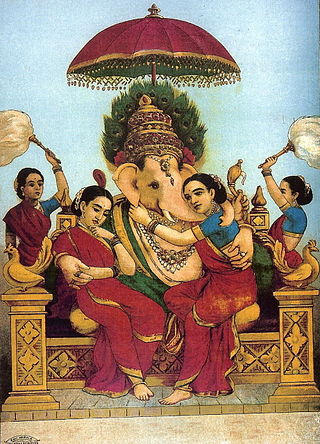
The marital status of Ganesha varies widely in mythological stories and the issue has been the subject of considerable scholarly review. Several patterns of associations with different consorts are identifiable. One pattern of myths identifies Ganesha as an unmarried brahmacārin with no consorts. Another mainstream pattern associates him with the concepts of Buddhi (intellect), Siddhi, and Riddhi (prosperity); these qualities are sometimes personified as goddesses who are considered to be Ganesha's wives. Another pattern connects Ganesha with the goddess of culture and the arts, Sarasvati. In the Bengal region he is linked with the banana tree, Kala Bo. Usually Ganesha's consort is portrayed as his shakti, a personification of his creative energy.

Ganesha, also spelled Ganesh, and also known as Ganapati, Vinayaka, and Pillaiyar, is one of the best-known and most worshipped deities in the Hindu pantheon and is the Supreme God in the Ganapatya sect. His depictions are found throughout India. Hindu denominations worship him regardless of affiliations. Devotion to Ganesha is widely diffused and extends to Jains and Buddhists and beyond India.

The Murugan Temple of North America is the first temple in the United States that is dedicated to the Hindu deity Murugan. The temple is located in Lanham, Maryland, about 5 miles (8.0 km) from Washington, D.C. Conceived in the 1980s and opened in 1999, the temple celebrates all Hindu and Tamil festivals, holidays and special occasions. In addition, the temple conducts bhajans, Tamil and religious classes. Devotees from Maryland, Washington, Virginia and throughout the country visit this traditional Saivite Hindu temple. The main sannidhi at the temple is for Murugan with Valli and Devasena. There are four other sannidhis, for Vinayaka (Ganesha), Siva, Meenakshi, Durga and Palani Aandavar.
Urkeri is a small village located in the district of Uttar Kannada in the state of Karnataka in India. It has a population of about 963 persons living in around 214 households. Urkeri is a temple Village. The main deity is Lord Ganesh. Lord Ganesha is revered as the village God in these villages, in the north Kanara district. The chariot ceremony of Ganapati is celebrated on Maghi Pournima. The temple is the main attraction at Urkeri, receiving many devotees per year. Urkeri Shree Swayambhoo Devasthana is an ancient temple.

Sri Poyatha Moorthi Temple is the oldest existing/intact Hindu temple in Malaysia and one of the oldest functioning Hindu temples in Maritime Southeast Asia. Located in the state of Malacca, the temple is one of the few existing Chitty temples in Malaysia.
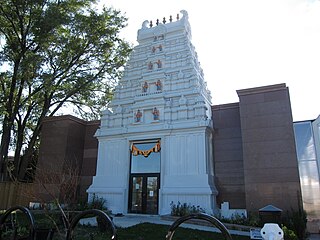
The Sringeri Sharadamba Temple of Toronto, , is a Hindu temple located in Etobicoke, Toronto, Ontario, Canada. The temple is dedicated to Goddess Sharadamba. It is more popularly known as SVBF Canada or Sringeri Vidya Bharati Foundation Canada. The temple is modelled after the original 8th-century Sringeri Sharadamba Temple located at Sringeri in Chikkamagaluru District in Karnataka, India.

Manakula Vinayagar Temple is a Hindu temple in the Union Territory of Puducherry, India. Dedicated to the god Ganesa, it is a popular pilgrimage site and tourist destination in Puducherry. The temple is of considerable antiquity and predates French occupation of the territory. During the tenure of Dupleix, there were attempts to destroy the temple, but it was spared owing to strong protests from the Hindu population and the threat of British and Maratha invasion of the territory.
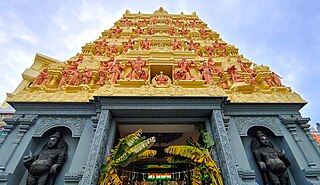
Sri Senpaga Vinayagar Temple is a temple for the Hindu god Ganesha who is the presiding deity. It is located at Ceylon Road in Singapore.

Kottarakkara Sree Mahaganapathy Kshethram is a pilgrim centre in South India. It is centuries old and the most important Maha Ganapathi Temple in Kerala. Non-Hindus are permitted. It is the family of Lord Siva. This Ganapati temple is located in Kottarakkara which is 25 km from Kollam.
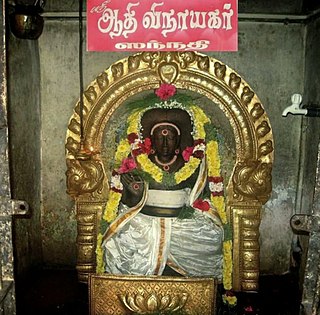
Adhi Vinayaka is a form of the Hindu deity Ganesha (Vinayaka), which portrays Ganesha with a human head, prior to being decapitated by his father, Shiva. This specific form of Ganesha is rarely worshipped, with only few dedicated shrines, such as the one near Koothanur, Tamil Nadu. The word aadi or aadhi (आदि) means the 'first', and aadi-vinaayaka = "Vinayak in his first form", when he had a human head.

Kapardeeswarar temple is a Hindu temple situated in the village of Thiruvalanchuzhi near Swamimalai in Kumbakonam taluk of Thanjavur district, Tamil Nadu, India. Shiva is worshiped as Kapardeeswarar and is represented by the lingam and his consort Parvati is depicted as Brihannayagi. The presiding deity is revered in the 7th century Tamil Saiva canonical work, the Tevaram, written by Tamil poet saints known as the nayanars and classified as Paadal Petra Sthalam.















